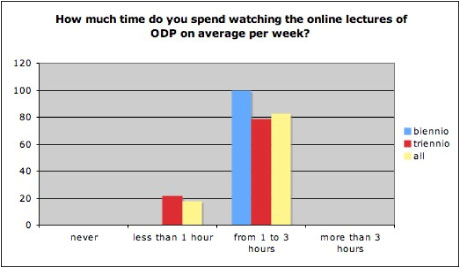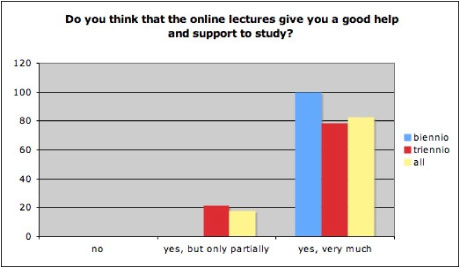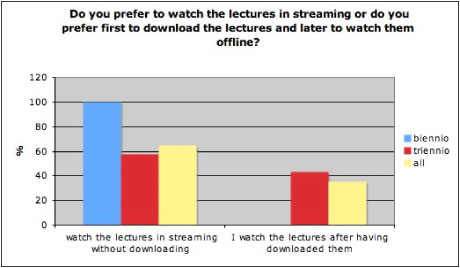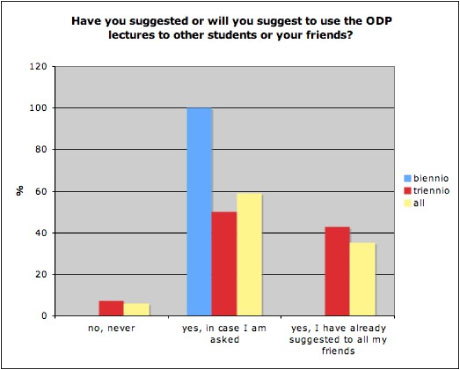High School Open On-line Courses (HOOC):
A Case Study from Italy
Enrique Canessa [canessae@ictp.it], ICTP –
The Abdus Salam International Centre for Theoretical Physics, Trieste,
Armando Pisani [arpisan@tin.it], Liceo Classico Dante Alighieri, Gorizia, Italy
Abstract
The first implementation of complete high school, open on-line courses (HOOC) aiming to support the training and basic scientific knowledge of young students from the Liceo Ginnasio Dante Alighieri in Gorizia, Italy, is discussed. Using the open source and automated recording system openEyA, HOOC give an student the opportunity to watch on-line, at their own place and own pace, the same lessons of physics and mathematics held in the classroom. It is found that high school students’ have changed the traditional modality of study and their scores have systematically improved since the implementation of this project. In only few months the use by students of the www.OpenDante.it video archive for HOOC has growth from 30 % to 97 %. Feedback from students and Parents on the use and impact of making HOOC available on the web are encouraging.
Keywords: Computers and Education, Learning, Schools, Webcasting
Introduction
The technology to implement live video streaming and on-demand video recordings through different means, including the new mobile devices, is getting robust and cost effective. Educational video archives such as the pioneering MIT OpenCourseWare, and the ICTP pre-PhD Diploma Courses On-line for physics and mathematics (Canessa et al., 2009a) are increasing their popularity with scholars around continents. Most recently, the implementation of Massive Open On-line Courses (MOOC) (Waters, 2012; Canessa et al., 2013) by EdX.org of MIT and Harvard are opening also new ways to get free and quality education for all at zero cost for the students so far.
Nevertheless, there are less efforts reported in the literature for supporting and facilitating complete educational recordings given to students at high schools (ages 14 to 18 years old) (Saunders & Hutt, 2012), especially now that they have easier access to Internet using PCs at home and a large variety of mobile devices to facilitate their academic activities. Little support has been given to the possibility of implementing high school open on-line courses (HOOC), which should be optimized for recording also traditional classroom lectures of typically 55 minutes in the field of physics and mathematics.
In this paper we shall describe our implementation of HOOC in Italy within the OpenDante (ODP) project directed to high school students at the Liceo Classico Dante Alighieri in the town of Gorizia. The main goal is to give the opportunity to our students (and not only) to follow (i.e., watch again at their own place and pace) on-line lessons of physics and mathematics held in the classroom – see website: www.OpenDante.it, which we believe it can be a good example to be followed by other schools world-wide. The ODP for HOOC uses the open source automated recording system openEyA available for download from www.openeya.org (Canessa et al., 2009b).
Automated openEyA Recording System
The automated recording system openEyA (which stands for “Enhance your Audience”) (Canessa et al., 2009b) is an innovative, free and open-source system developed to archive and share physics and mathematics lectures carried out using either digital (PPT, PDF, etc.) presentations or the old and traditional blackboard with the use of a chalk. It is a completely automated, non-intrusive and low-cost recording system, which allows the recording of scientific lectures without any dedicated human intervention for post-processing or video capturing. Furthermore, lecturers are not requested to follow any special technical constraints like pressing buttons or wearing a microphone, etc., but to deliver their lectures naturally.
The design of openEyA consists of the recording of video and audio via a portable Ubuntu-based computer having two connected USB HD webcams, plus an omni-directional USB microphone. The total cost for this simple set up being about 450 Euro as of this date. With one webcam, high resolution images are taken every few seconds and with a second one videos are recorded. The recording time can be set in slots of one hour to follow usual classroom schedules. After finishing each recording, all images, together with the audio-video and the information about the timing of these streams, are then processed automatically and zipped into a file (with average dimension less than 85MB per recorded hour). openEyA is a scalable system and can be used in any type of classroom.
The synchronization between the images and the movie is done via a flash openeya.swf player. Images are automatically compared with each other to drop duplicates (i.e., images that do not change with respect to the previous one above a given threshold), in order to decrease the space for storage and to facilitate the fast download of the final synchronized recordings. At the end of this process, all images, thumbnails, flash video and synchronization track are mixed together in a web page, with a zooming area facility to allow the reading of small details on a blackboard – such as a tiny dot indicating the mathematical symbol for the derivative.
A screenshot of the web output of a recorded lecture with audio, flash video and synchronized JPG images of the blackboard is illustrated in Figure 1, with the possibility of zooming up areas of the blackboard at high resolution. openEyA video recordings also offer the benefit of seeing the accompanying physical gestures of the lecturer, the body language and the like which are inherent in the pedagogical process. These recordings can also serve as a main content source in a number of different didactic scenarios: for instance, in the present OpenDante project for high schools lectures and the pre-PhD ICTP Diploma Courses On-line of physcs and mathematics (Canessa et al., 2009a). The creative environment of, and the enchanting moments in, classrooms can now be fairly reproduced using openEyA.
openEyA aims to widen the audience of educational activities at no extra costs for the viewers and the Institutions providing this service, and to offer a high quality learning experience of scientific material. The final recordings look similar (or very close) to being present in the classroom. The software can be downloaded from the website: www.openeya.org.

Figure 1. Example of openEyA recorded lecture in the OpenDante project. Audio and video are displayed on top left, and synchronized images are shown below. OnMouseOver, the arrow opens a high resolution zoomed area of the image (on the right) where even a dot can be distinguished.
OpenDante Project: Assessments and Discussion
High Schools in the Italian educational system are divided into Classical and Scientific subjects and differ because of their different purposes – a complete and updated description of the Italian Educational System can be found at Eurydice website. Traditionally, the Liceo Classico as such was the first school to train students for subsequent access to all faculties at the University. Nowadays, students can access most University courses after having passed a final exam (i.e., “Esame di Stato”: previously known as “Esame di Maturita’”) to complete the high school cycle which normally starts at 14 and is completed at 18 years. Students are involved in a total of 27 lessons (of 60 minutes each, usually redistributed into 30 lectures each lasting for 55 minutes) per week during the first two years, while in the last three years weekly lessons increase to a total of 31 hours. The high school Italian system, before the last reform in 2010, divides the students into two year ranges: the first two years of high school classes are called “biennio” while the last three years are called “triennio”.
The Liceo Ginnasio “Dante Alighieri” in Gorizia, Italy – a section of the Istituto Statale di Istruzione Superiore (I.S.I.S.), mainly offers courses in arts and humanities and also a certain amount of compulsory lessons in the areas of physics and mathematics according to its official program of studies. After completing the five years high school curriculum, a significant fraction of students from the Liceo apply for, and follows up, scientific faculties at the University. For this reason, the OpenDante project was developed to improve and support the scientific training of students starting from an early age. As we shall discuss next, the ODP has not only immediate benefits for the students in terms of scores, but it also helps to reinforce their basic scientific knowledge and interest in science.
At present, the ODP involves two subjects: mathematics and physics, since these are the subjects that one of the Authors (A.P.) teaches in this high school. The idea leading to ODP dates back to the beginning of 2012 when A.P. found that a large number of U.S. Universities made lectures available on iTunes. The opportunity to watch a full course on a PC seemed to be a great opportunity to help students choose their University and to improve their results at the University exams. Then both of the Authors met at an international meeting held in Trieste in June 2012 and started to exchange ideas on how to adapt the idea of implementing complete high school open on-line courses (HOOC). The free and open source openEyA software to carry out automated digital recordings of traditional lectures was the best tool identified to realize the project. This because of the experiences gained by one of the Authors (E.C.) and the ICTP Science Dissemination Team in Trieste, Italy in recording thousands of hours of ICTP pre-PhD Diploma Courses On-line (Canessa et al., 2009a).
The first lecture was successfully recorded on September 28th, 2012 and to this date (February 2013) a total of 94 lectures are available for on-demand vision or download (as a zipped file) through the website: www.OpenDante.it. The total number of students normally present during the recorded lectures was 80 boys and girls distributed in 4 different classes ranging from 15 to 18 years old. Within this group, 18 belong to the biennio, while 62 belong to the triennio. The number of mathematics lectures is 57, while the physics lectures amount to 30. Of these, seven lectures concern topics added to the usual curricular material. Among the total number of recorded lectures, the openEyA software failed in only two cases (because the HD USB webcam did not work properly and some of the recorded images resulted out of focus). However, the video and audio of these two lectures were properly recorded by the second low-resolution webcam and the lectures are understandable. The automated openEyA recording system was found easy to use, with a minimum teacher administration, and giving satisfactory results as discussed next.
Students and their parents were asked to fulfil an on-line questionnaire concerning their experiences and opinions about the ODP. This exercise was useful in order to i) attempt to identify the implications and engagement of giving high school students the opportunity to watch again (at their own place and pace), the same lessons of physics and mathematics held in the classroom, and ii) obtain a feedback on the use and effects of making HOOC available on the web. After a deadline of two weeks, the answers were collected and analyzed and the results are reported in the tables below, together with the set of questions.
Table 1: Students: Questions & Answers
Questions |
Answers |
How much time do you spend watching the online lectures of ODP on average per week? |
a) never: 0 % b) less than one hour: 18 % c) from 1 to 3 hours: 82 % d) more than 3 hours: 0 % |
Do you think that the on-line lectures give you a good help and support to study? |
a) no, not at all: 0 % b) yes, but only partially: 18 % c) yes very much: 82 % |
Do you watch the lectures during the time normally dedicated to studying the subjects involved or do you watch the on-line lectures also during your spare time or the weekend? |
a) I watch the online lecture only during the time dedicated to study: 6 % b) on average, during the time normally dedicated to study, rarely during the weekend: 53 % c) mainly during my spare time and during the weekend: 41 % |
Do you prefer to watch the lectures in streaming or do you prefer first to download the lectures and later to watch them off-line? |
a) I watch the lectures in streaming without downloading : 65 % b) I watch the lectures after having downloaded them: 35 % |
Have you suggested or will you suggest using the ODP lectures to other students or your friends? |
a) no, never: 6 % b) yes, in case I may be asked: 59 % c) yes, I have already suggested to watch the lectures to most of my friends: 35 % |
If you have watched the lectures of both subjects (math and physics), which one do you prefer? |
a) I prefer math: 21 % b) both are OK: 50 % c) I prefer physics: 29 % |
A noteworthy feature from theses answers is that 100 % of the younger students (from the biennio) spend from 1 to 3 hours watching the ODP lectures, and all of them believe that the on-line lectures gave them help and support in their study. The younger adolescents are more open to share this on-line pedagogical experience with others than their peers of the triennio. These interesting facts can be deduced from Figure 2 where we show the main difference between biennio and triennio students. All of these students were equally following ODP lectures during the time normally dedicated to study and rarely during the weekend. They used a PC at home to watch the on-line lectures, no use of Tablets with Android OS were reported.




Figure 2. Histograms showing the main differences between answers (in percentage with respect to the total in yellow) from the younger biennio students (In blue) against their peers in the triennio (in red).
Students’ parents were also asked to answer some questions in order to have a more complete picture for the ODP. The answers received are compiled in Table 2; nicely, 100 % of these are in favour of the opportunity that their son/daughter can follow ODP on-line lectures to support the curricular subjects. In the Parents’ opinions, we notice a better defined tendency, with respect to students’ replies, pointing towards a strong 100 % appreciation of ODP on-line lectures. Parents did watch some of the on-line lectures too.
For a better understanding of HOOC impact on the results of subjects’ assessments, students were also asked to indicate on their worksheets (written exams) whether or not they have used the ODP on-line lectures when studying the topics involved in the test. The Italian scale of scores for a test sets the minimum positive score at 6, while the top score is 10 and the worse score is 2. The total number of tests involved in this assessment evaluation was 102. The fraction of students who have used ODP lectures while studying was 32 %.
The mean score of students who did not use ODP lectures was 7.06, with a standard deviation of 1.59, while the mean score of the students who watched ODP lectures was 8.07, with a standard deviation of 1.53. The median for non-ODP students was 7, while for ODP students we got 8.5. This rank test indicates that the scores of non-ODP tests are smaller than ODP tests with a significant level of 99 % success.
Table 2: Students’ Parents: Questions & Answers
Questions |
Answers |
Do you believe that the opportunity to watch the ODP lectures is a useful help to students, both for studying and for homeworking? |
a) no: 0 % b) yes, but only partially: 0 % c) yes, very much: 100 % |
Have you suggested or will you suggest watching ODP lectures to other students or parents? |
a) no: 6 % b) yes: 94 % |
Have you watched the ODP lectures? |
a) no: 20 % b) yes, I have watched some lectures: 80 % c) yes, I watched almost all the lectures: 0 % |
In Figure 3 we report the histograms for the scores of non-ODP and ODP test assessments and in Figure 4 we show the cumulative distributions of both kinds of scores. From the figures, the systematic effect is quite clear, although the Kolmogorov-Smirnov test (Holliday, 2012; SciLab Enterprises) does not show a significant difference, mainly because of the reduced size of the sample. For completeness, we admit the possibility that this result could be biased by the fact that it is likely that only the most diligent students have used ODP lectures to prepare their tests. However, according to the students’ opinion, ODP lectures give an important support to their study and homework in all cases.

Figure 3. Histogram of test scores. ODP scores (in red) vs. non-ODP (in blue). Black: all.

Figure 4. Cumulative distributions of test scores: in green ODP scores and in black non-ODP scores. It appears quite clearly that ODP scores are systematically shifted towards higher values relatively to non-ODP scores.
Remarks
In order to verify our interpretation of the questionnaire as discussed above, we asked a sub-sample of the 35 students aged 16 to 17 years old to compile a new and simplified second version of the questionnaire at the end of the scholar year (June 2013). The most important result obtained is that the fraction of students that use the OpenDante recorded lectures during their homework has risen from 30 % to almost 97 % in only few months. All of the other answers received generally confirmed those obtained in our first questionnaire.
We also asked the students to motivate further their use of the OpenDante recorded lectures after the experience of watching these videos for few months already. Students stressed mainly the fact that OpenDante allows them to recover the lectures they miss, maybe because of illness or any other good reason. They also admitted that some of them do not dare to ask questions during the morning lectures and the opportunity to revise again throughout the whole lecture at home allows them to cast light on topics they have not well understood while in the classroom.
Some students pointed out that the opportunity to have the lectures at their disposal at any time makes them more confident since they can understand the content of the lecture maybe at the second or third viewing and listening of the lecture. This fact is clearly impossible if the recordings of all the lectures were not available to them on-line. Other students indicated that normally the discussion of a given content made by the Teacher is more simple and understandable that the descriptions on same topics they can find and read in textbooks and this helps them during their study of that content on-line. Almost all students indicated that by using OpenDante lectures, their homework has become more efficient, saving lot of time of frustration.
On the basis of these students’ answers and assessments, as well as from the supportive reactions from their Parents, we can argue that the large majority of students watching the HOOC in the ODP believe that this optional facility helps them significantly for both: their study and homeworking. This conclusion is also supported by the fact that our younger students have suggested or will suggest to their friends to use ODP on-line lectures.
As far as we can deduce from the reported data, and by our own experience with the recording of complete on-line courses at post-graduate and University levels (Canessa et al., 2009a), we can say that the use of openEyA has proved to be a valuable tool to support the study and homework of all the students who have exploited this opportunity. The possibility to make curricular lectures also available online to students of an Italian High School (Liceo Classico) has shown to be feasible and low-cost. This is coherently reinforced by the suggestion made by students and Parents to extend the OpenDante project to other non-scientific subjects.
Since students can see the lecturers outside school time, we consider this methodology as appropriate stimulus to avoid retention loss (or forgetting), as opposed to the decay of memories over time or interference from other memories – which are stored in our short term and long term memory system (Miller, 1956; Murphy et al., 2006). These digital contents aim to increase attention and retention of a lecture and to reduce the Primacy-Recency effect (Sousa, 2011; Tulving, 1972). During the learning episode, one not only remembers best what comes first, or what come last, but with the help of videos, one can have now better access to, and retain, the information.
In the new era of self-paced education and learning, we can say that students definitely do appreciate the opportunity to have the OpenDante recorded lectures for several reasons. They feel free to concentrate on the discussed topics without any fear to loose any important part, since it is always possible to stop the recording and to re-listen the explanations until one has a clear comprehension of the subject in question. In case students are still unable to understand the contents of a lecture, it is always possible to ask the teacher during the next lecture with a basis, and this allows them to clarify what they have understood and what they have not. We have verified that students get more successful performances and evaluation assessments with HOOC.
The future developments of similar projects strongly depend on the will of teachers interested in HOOC to give high school students the opportunity to follow and revise the lectures beyond their classrooms.
References
- Canessa, E.; Fonda, C. and Zennaro, M. (2009a). One Year of ICTP Diploma Courses On-line Using the Automated EyA Recording System. In Computers & Education, 53, (p. 183).
- Canessa, E.; Fonda, C. and Zennaro, M. (2009b). Supporting Science in Developing Countries using Open Technologies. In European Journal of Physics, 30, (p. 651).
- Canessa, E.; Tenze, L. and Salvatori, E. (2013). Attendance to Massive Open On-line Courses: Towards a Solution to Track on-line Recorded Lectures Viewing. In IEEE TCLT Bulletin, 1 Jan 2013.
- EACEA (n.d.). Eurydice website. http://eacea.ec.europa.eu/education/eurydice/eurypedia_en.php
- Holliday, I.E. (2012). Kolmogorov-Smirnov Test (v1.0.3) in Free Statistics Software (v1.1.23-r7), Office for Research Development and Education: http://www.wessa.net/rwasp_Reddy-Moores%20K-S%20Test.wasp/
- Miller, G.A. (1956). The Magical Number Seven, Plus or Minus Two: Some Limits on Our Capacity for Processing Information. In Psychological Review, 63, (p. 81).
- MIT OpenCourseWare (n.d.). Free Online Course Materials, http://ocw.mit.edu
- Murphy, J. Hofacker, C. and Mizerski, R. (2006). Primacy and Recency Effects on Clicking Behavior. In Journal Computer-Mediated Communication, 11, 7th article.
- Saunders, F. and Hutt, I. (2012). Richness, Responsiveness and Relationship: Using Rich-media Materials to Enhance the Teaching of Core Concepts. In Proceedings Engineering Education 2012, Coventry University, UK, Sept. 2012.
- SciLab Enterprises (n.d.). SciLab Software. http://www.scilab.org
- Sousa, D.A. (2011). How the Brain Learns. SAGE Publications Ltd, ISBN: 9781412997973
- Tulving, E. (1972). Episodic and Semantic Memory. In E. Tulving and W. Donaldson (eds.), Organization of Memory, (pp. 381-402). New York: Academic Press.
- Waters, A. (2012). Top Ed-Tech Trends of 2012: MOOCs. http://hackeducation.com/2012/12/03/top-ed-tech-trends-of-2012-moocs/
Acknowledgements
One of the authors (A. P.) thanks the students and Parents participating in the HOOC, and the support by the principal of the Liceo Dante Alighieri di Gorizia Prof. Giovanna Marson. E. C. acknowledges his colleagues at ICTP-SDU: Carlo Fonda, Livio Tenze and Marco Zennaro for a fruitful collaboration with openEyA.

